Exploring Omni-Channel Retailing: Key Concepts and Frameworks
VerifiedAdded on 2020/05/04
|10
|2029
|69
AI Summary
The transition from multi-channel to omni-channel retailing is reshaping the landscape of supply chain management and customer engagement. This assignment examines significant themes within this transformation, including the three-dimensional framework for understanding omnichannel dynamics, integration strategies for seamless cross-channel marketing, realignment of physical distribution processes, and inventory management in an interconnected retail environment. Key references like Ailawadi & Farris (2017) discuss metrics and research directions for multi-and omni-channel distribution. Other studies highlight the impact of distribution systems on fulfillment efficiency, such as those by Hübner et al. (2016), which provide a strategic framework for grocery retailers adopting omni-channel models. This summary encapsulates how contemporary retail strategies leverage advanced supply chain management techniques to meet consumer demands and maintain competitive advantage.

Running head: SUPPLY CHAIN PRINCIPLES
Supply Chain Principles
Name of Student
Name of the University
Author Note
Supply Chain Principles
Name of Student
Name of the University
Author Note
Paraphrase This Document
Need a fresh take? Get an instant paraphrase of this document with our AI Paraphraser
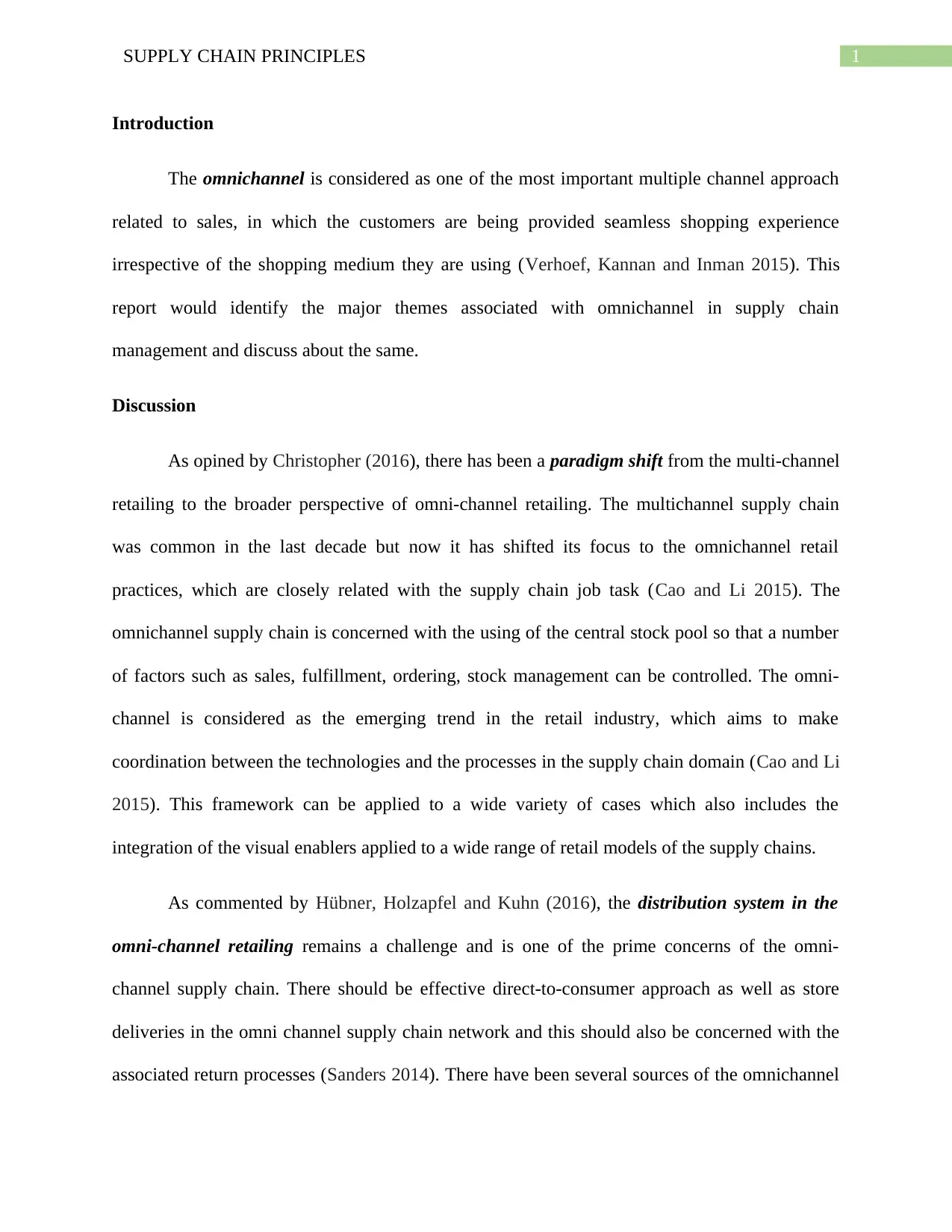
1SUPPLY CHAIN PRINCIPLES
Introduction
The omnichannel is considered as one of the most important multiple channel approach
related to sales, in which the customers are being provided seamless shopping experience
irrespective of the shopping medium they are using (Verhoef, Kannan and Inman 2015). This
report would identify the major themes associated with omnichannel in supply chain
management and discuss about the same.
Discussion
As opined by Christopher (2016), there has been a paradigm shift from the multi-channel
retailing to the broader perspective of omni-channel retailing. The multichannel supply chain
was common in the last decade but now it has shifted its focus to the omnichannel retail
practices, which are closely related with the supply chain job task (Cao and Li 2015). The
omnichannel supply chain is concerned with the using of the central stock pool so that a number
of factors such as sales, fulfillment, ordering, stock management can be controlled. The omni-
channel is considered as the emerging trend in the retail industry, which aims to make
coordination between the technologies and the processes in the supply chain domain (Cao and Li
2015). This framework can be applied to a wide variety of cases which also includes the
integration of the visual enablers applied to a wide range of retail models of the supply chains.
As commented by Hübner, Holzapfel and Kuhn (2016), the distribution system in the
omni-channel retailing remains a challenge and is one of the prime concerns of the omni-
channel supply chain. There should be effective direct-to-consumer approach as well as store
deliveries in the omni channel supply chain network and this should also be concerned with the
associated return processes (Sanders 2014). There have been several sources of the omnichannel
Introduction
The omnichannel is considered as one of the most important multiple channel approach
related to sales, in which the customers are being provided seamless shopping experience
irrespective of the shopping medium they are using (Verhoef, Kannan and Inman 2015). This
report would identify the major themes associated with omnichannel in supply chain
management and discuss about the same.
Discussion
As opined by Christopher (2016), there has been a paradigm shift from the multi-channel
retailing to the broader perspective of omni-channel retailing. The multichannel supply chain
was common in the last decade but now it has shifted its focus to the omnichannel retail
practices, which are closely related with the supply chain job task (Cao and Li 2015). The
omnichannel supply chain is concerned with the using of the central stock pool so that a number
of factors such as sales, fulfillment, ordering, stock management can be controlled. The omni-
channel is considered as the emerging trend in the retail industry, which aims to make
coordination between the technologies and the processes in the supply chain domain (Cao and Li
2015). This framework can be applied to a wide variety of cases which also includes the
integration of the visual enablers applied to a wide range of retail models of the supply chains.
As commented by Hübner, Holzapfel and Kuhn (2016), the distribution system in the
omni-channel retailing remains a challenge and is one of the prime concerns of the omni-
channel supply chain. There should be effective direct-to-consumer approach as well as store
deliveries in the omni channel supply chain network and this should also be concerned with the
associated return processes (Sanders 2014). There have been several sources of the omnichannel
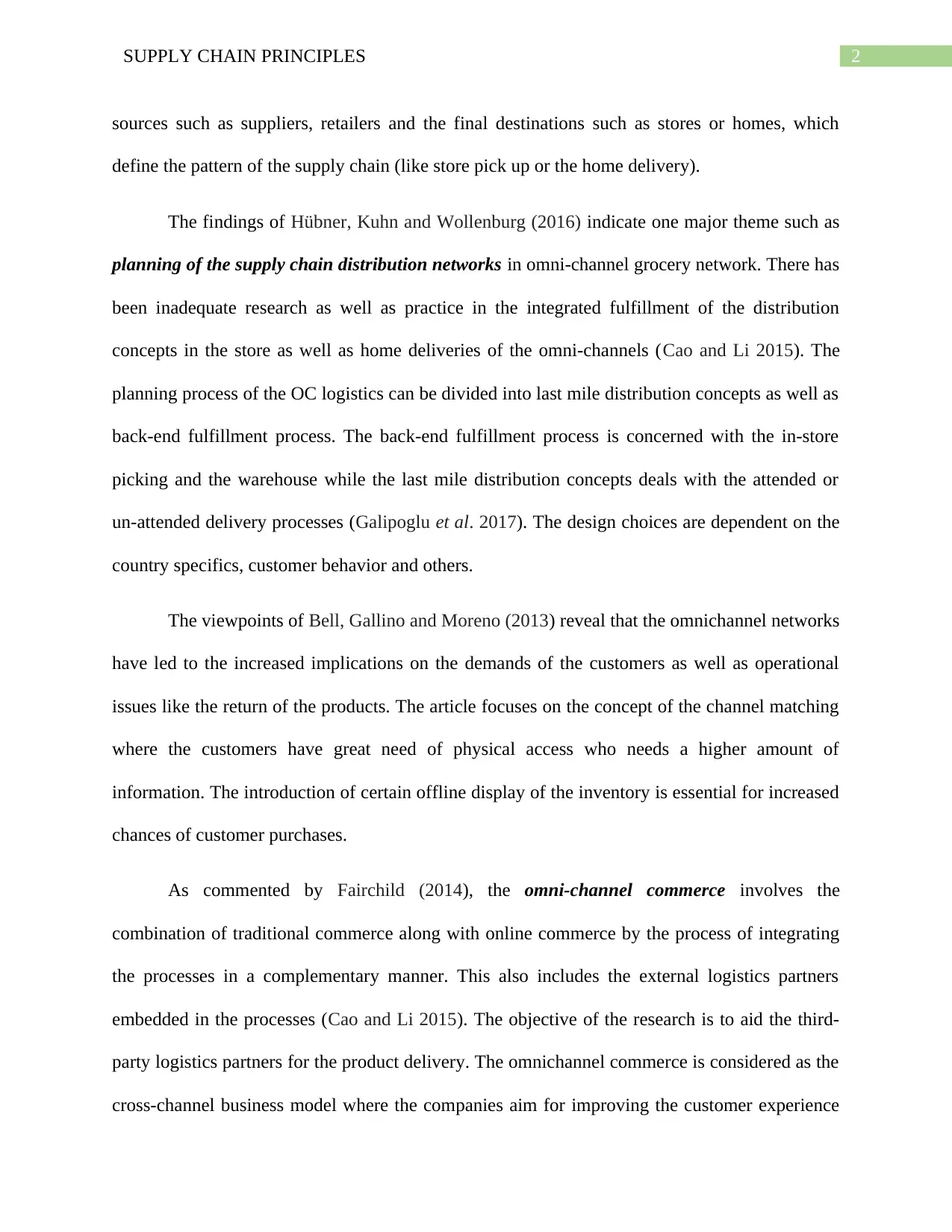
2SUPPLY CHAIN PRINCIPLES
sources such as suppliers, retailers and the final destinations such as stores or homes, which
define the pattern of the supply chain (like store pick up or the home delivery).
The findings of Hübner, Kuhn and Wollenburg (2016) indicate one major theme such as
planning of the supply chain distribution networks in omni-channel grocery network. There has
been inadequate research as well as practice in the integrated fulfillment of the distribution
concepts in the store as well as home deliveries of the omni-channels (Cao and Li 2015). The
planning process of the OC logistics can be divided into last mile distribution concepts as well as
back-end fulfillment process. The back-end fulfillment process is concerned with the in-store
picking and the warehouse while the last mile distribution concepts deals with the attended or
un-attended delivery processes (Galipoglu et al. 2017). The design choices are dependent on the
country specifics, customer behavior and others.
The viewpoints of Bell, Gallino and Moreno (2013) reveal that the omnichannel networks
have led to the increased implications on the demands of the customers as well as operational
issues like the return of the products. The article focuses on the concept of the channel matching
where the customers have great need of physical access who needs a higher amount of
information. The introduction of certain offline display of the inventory is essential for increased
chances of customer purchases.
As commented by Fairchild (2014), the omni-channel commerce involves the
combination of traditional commerce along with online commerce by the process of integrating
the processes in a complementary manner. This also includes the external logistics partners
embedded in the processes (Cao and Li 2015). The objective of the research is to aid the third-
party logistics partners for the product delivery. The omnichannel commerce is considered as the
cross-channel business model where the companies aim for improving the customer experience
sources such as suppliers, retailers and the final destinations such as stores or homes, which
define the pattern of the supply chain (like store pick up or the home delivery).
The findings of Hübner, Kuhn and Wollenburg (2016) indicate one major theme such as
planning of the supply chain distribution networks in omni-channel grocery network. There has
been inadequate research as well as practice in the integrated fulfillment of the distribution
concepts in the store as well as home deliveries of the omni-channels (Cao and Li 2015). The
planning process of the OC logistics can be divided into last mile distribution concepts as well as
back-end fulfillment process. The back-end fulfillment process is concerned with the in-store
picking and the warehouse while the last mile distribution concepts deals with the attended or
un-attended delivery processes (Galipoglu et al. 2017). The design choices are dependent on the
country specifics, customer behavior and others.
The viewpoints of Bell, Gallino and Moreno (2013) reveal that the omnichannel networks
have led to the increased implications on the demands of the customers as well as operational
issues like the return of the products. The article focuses on the concept of the channel matching
where the customers have great need of physical access who needs a higher amount of
information. The introduction of certain offline display of the inventory is essential for increased
chances of customer purchases.
As commented by Fairchild (2014), the omni-channel commerce involves the
combination of traditional commerce along with online commerce by the process of integrating
the processes in a complementary manner. This also includes the external logistics partners
embedded in the processes (Cao and Li 2015). The objective of the research is to aid the third-
party logistics partners for the product delivery. The omnichannel commerce is considered as the
cross-channel business model where the companies aim for improving the customer experience
⊘ This is a preview!⊘
Do you want full access?
Subscribe today to unlock all pages.

Trusted by 1+ million students worldwide

3SUPPLY CHAIN PRINCIPLES
(Raymond 2016). The companies using this concept give importance to customer values and try
to be in touch with the customers through more than one modes.
One of the most important themes in the omnichannel aspect of the supply chains is the
realignment of the physical distribution process for the different retailers who are usually store-
based so that the online business channel can be incorporated into the business model (Ishfaq et
al. 2016). It is important to align all the physical resources of the firm so that there is successful
integration of the online and the offline resources (Cao and Li 2015). This is one of the most
important approach in which the retailers are in the process of developing unique physical
distribution process in which there is a greater role of the physical distribution process in
delivery and fulfillment (Modak 2017). The size of the distribution network, number of years of
engagement and the number of sales associate at the store determine the nature of the
omnichannel infrastructure (Bernon, Cullen and Gorst 2016).
The central theme discussed by Ailawadi and Farris (2017) demonstrates the fact that it is
important to do omni-channel marketing, which would help in the greater awareness of this
concept among the consumers. The omni channel marketing has made shopping more favorable
among the customers and also for the marketers (Cao and Li 2015). The marketing efforts would
also be instrumental for the downstream retailers and the upstream suppliers (Fulgoni 2014).
This kind of marketing provides seamless experience to the customers where they are being
bombarded with both online medium as well as offline mediums. The omni-channel assumes that
the customers may commence with one channel as well as move to the other channel so that they
move towards a resolution.
The key points of Saghiri et al. (2017) reveal an important theme which is named as the
three-dimensional framework of the omni-channel. The three-dimensional framework of the
(Raymond 2016). The companies using this concept give importance to customer values and try
to be in touch with the customers through more than one modes.
One of the most important themes in the omnichannel aspect of the supply chains is the
realignment of the physical distribution process for the different retailers who are usually store-
based so that the online business channel can be incorporated into the business model (Ishfaq et
al. 2016). It is important to align all the physical resources of the firm so that there is successful
integration of the online and the offline resources (Cao and Li 2015). This is one of the most
important approach in which the retailers are in the process of developing unique physical
distribution process in which there is a greater role of the physical distribution process in
delivery and fulfillment (Modak 2017). The size of the distribution network, number of years of
engagement and the number of sales associate at the store determine the nature of the
omnichannel infrastructure (Bernon, Cullen and Gorst 2016).
The central theme discussed by Ailawadi and Farris (2017) demonstrates the fact that it is
important to do omni-channel marketing, which would help in the greater awareness of this
concept among the consumers. The omni channel marketing has made shopping more favorable
among the customers and also for the marketers (Cao and Li 2015). The marketing efforts would
also be instrumental for the downstream retailers and the upstream suppliers (Fulgoni 2014).
This kind of marketing provides seamless experience to the customers where they are being
bombarded with both online medium as well as offline mediums. The omni-channel assumes that
the customers may commence with one channel as well as move to the other channel so that they
move towards a resolution.
The key points of Saghiri et al. (2017) reveal an important theme which is named as the
three-dimensional framework of the omni-channel. The three-dimensional framework of the
Paraphrase This Document
Need a fresh take? Get an instant paraphrase of this document with our AI Paraphraser
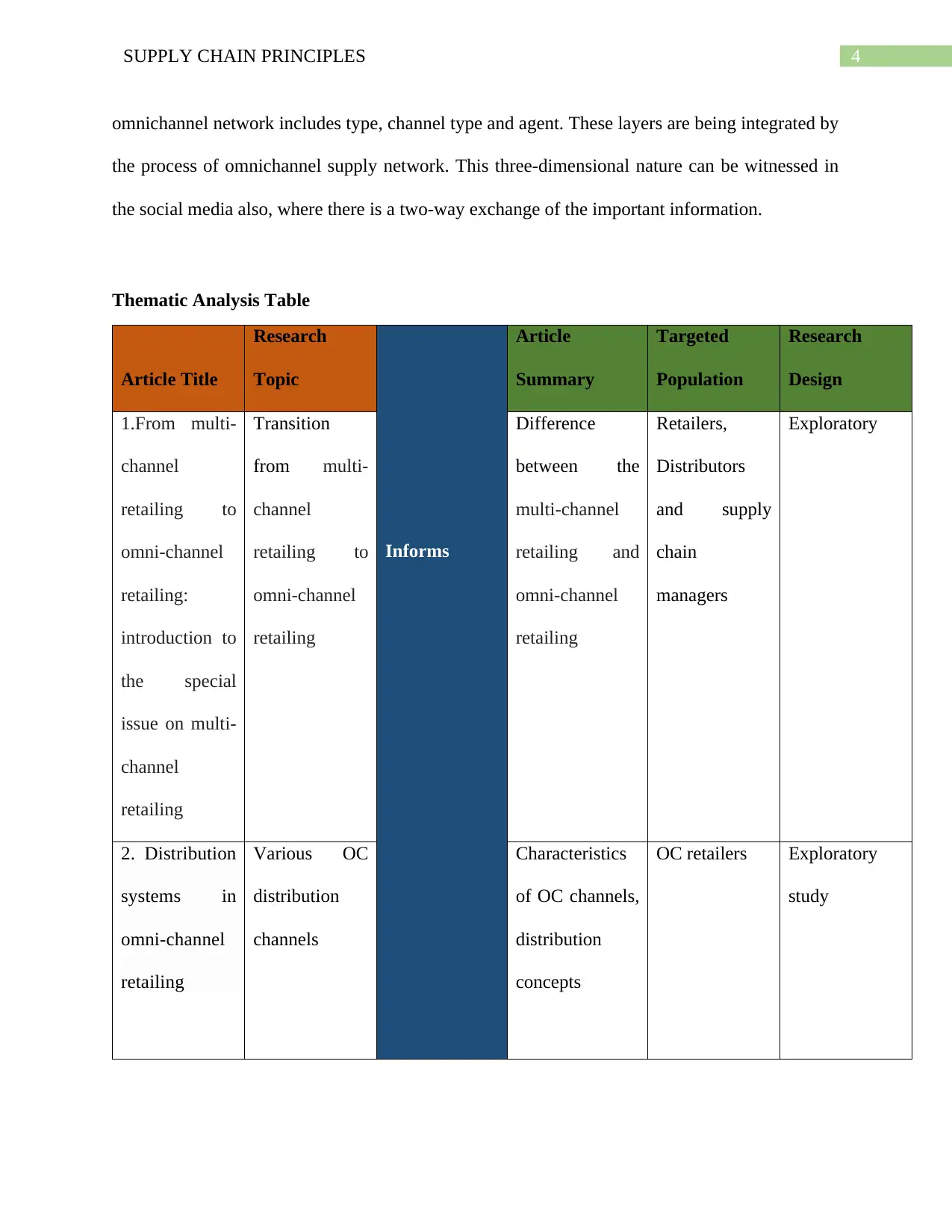
4SUPPLY CHAIN PRINCIPLES
omnichannel network includes type, channel type and agent. These layers are being integrated by
the process of omnichannel supply network. This three-dimensional nature can be witnessed in
the social media also, where there is a two-way exchange of the important information.
Thematic Analysis Table
Article Title
Research
Topic
Informs
Article
Summary
Targeted
Population
Research
Design
1.From multi-
channel
retailing to
omni-channel
retailing:
introduction to
the special
issue on multi-
channel
retailing
Transition
from multi-
channel
retailing to
omni-channel
retailing
Difference
between the
multi-channel
retailing and
omni-channel
retailing
Retailers,
Distributors
and supply
chain
managers
Exploratory
2. Distribution
systems in
omni-channel
retailing
Various OC
distribution
channels
Characteristics
of OC channels,
distribution
concepts
OC retailers Exploratory
study
omnichannel network includes type, channel type and agent. These layers are being integrated by
the process of omnichannel supply network. This three-dimensional nature can be witnessed in
the social media also, where there is a two-way exchange of the important information.
Thematic Analysis Table
Article Title
Research
Topic
Informs
Article
Summary
Targeted
Population
Research
Design
1.From multi-
channel
retailing to
omni-channel
retailing:
introduction to
the special
issue on multi-
channel
retailing
Transition
from multi-
channel
retailing to
omni-channel
retailing
Difference
between the
multi-channel
retailing and
omni-channel
retailing
Retailers,
Distributors
and supply
chain
managers
Exploratory
2. Distribution
systems in
omni-channel
retailing
Various OC
distribution
channels
Characteristics
of OC channels,
distribution
concepts
OC retailers Exploratory
study

5SUPPLY CHAIN PRINCIPLES
3. Last mile
fulfilment and
distribution in
omni-channel
grocery
retailing: A
strategic
planning
framework
Strategic
planning of the
omni channel
grocery
retailing
Informs
Planning of OC
grocery
retailing, pros
and cons of
different design
concepts
OC groceries Exploratory
interviews
4. Inventory
Showrooms
and Customer
Migration in
Omni-channel
Retail: The
Effect of
Product
Information
Effect of
Product
information on
customer
migration in
omni channel
retail
Emphasis on
physical display
of products in
omnichannel
retail
Retailers,
Consumers,
Supply chain
operators,
vendors
Empirical
setting and
econometric
approach
5. Extending
the Network:
Defining
Omnichannel
commerce
Third party
logistics (3PL)
partners for
Third party
logistics
partners,
SERVQUAL
methodology
and gap
3. Last mile
fulfilment and
distribution in
omni-channel
grocery
retailing: A
strategic
planning
framework
Strategic
planning of the
omni channel
grocery
retailing
Informs
Planning of OC
grocery
retailing, pros
and cons of
different design
concepts
OC groceries Exploratory
interviews
4. Inventory
Showrooms
and Customer
Migration in
Omni-channel
Retail: The
Effect of
Product
Information
Effect of
Product
information on
customer
migration in
omni channel
retail
Emphasis on
physical display
of products in
omnichannel
retail
Retailers,
Consumers,
Supply chain
operators,
vendors
Empirical
setting and
econometric
approach
5. Extending
the Network:
Defining
Omnichannel
commerce
Third party
logistics (3PL)
partners for
Third party
logistics
partners,
SERVQUAL
methodology
and gap
⊘ This is a preview!⊘
Do you want full access?
Subscribe today to unlock all pages.

Trusted by 1+ million students worldwide

6SUPPLY CHAIN PRINCIPLES
Product
Delivery
Partnering
Preferences for
Omni-channel
Commerce
product delivery
and emergence
of omnichannel
ecommerce
owners
analysis
6. Realignment
of the physical
distribution
process in
omni-channel
fulfillment
Physical
distribution
process in
omni-channel
How to align
the distribution
process in order
to meet the
needs of the
omnichannel
Retailers,
Distributors,
Sales
Executives
Quantitative
and Qualitative
Toward a
three-
dimensional
framework for
omni-channel
Various
aspects of the
omnichannel
network
Three-
dimensional
framework for
the omni-
channels are
being discussed
Retail Supply
chains,
Managers
Empirical and
secondary
study
(Source: Created by author)
Product
Delivery
Partnering
Preferences for
Omni-channel
Commerce
product delivery
and emergence
of omnichannel
ecommerce
owners
analysis
6. Realignment
of the physical
distribution
process in
omni-channel
fulfillment
Physical
distribution
process in
omni-channel
How to align
the distribution
process in order
to meet the
needs of the
omnichannel
Retailers,
Distributors,
Sales
Executives
Quantitative
and Qualitative
Toward a
three-
dimensional
framework for
omni-channel
Various
aspects of the
omnichannel
network
Three-
dimensional
framework for
the omni-
channels are
being discussed
Retail Supply
chains,
Managers
Empirical and
secondary
study
(Source: Created by author)
Paraphrase This Document
Need a fresh take? Get an instant paraphrase of this document with our AI Paraphraser
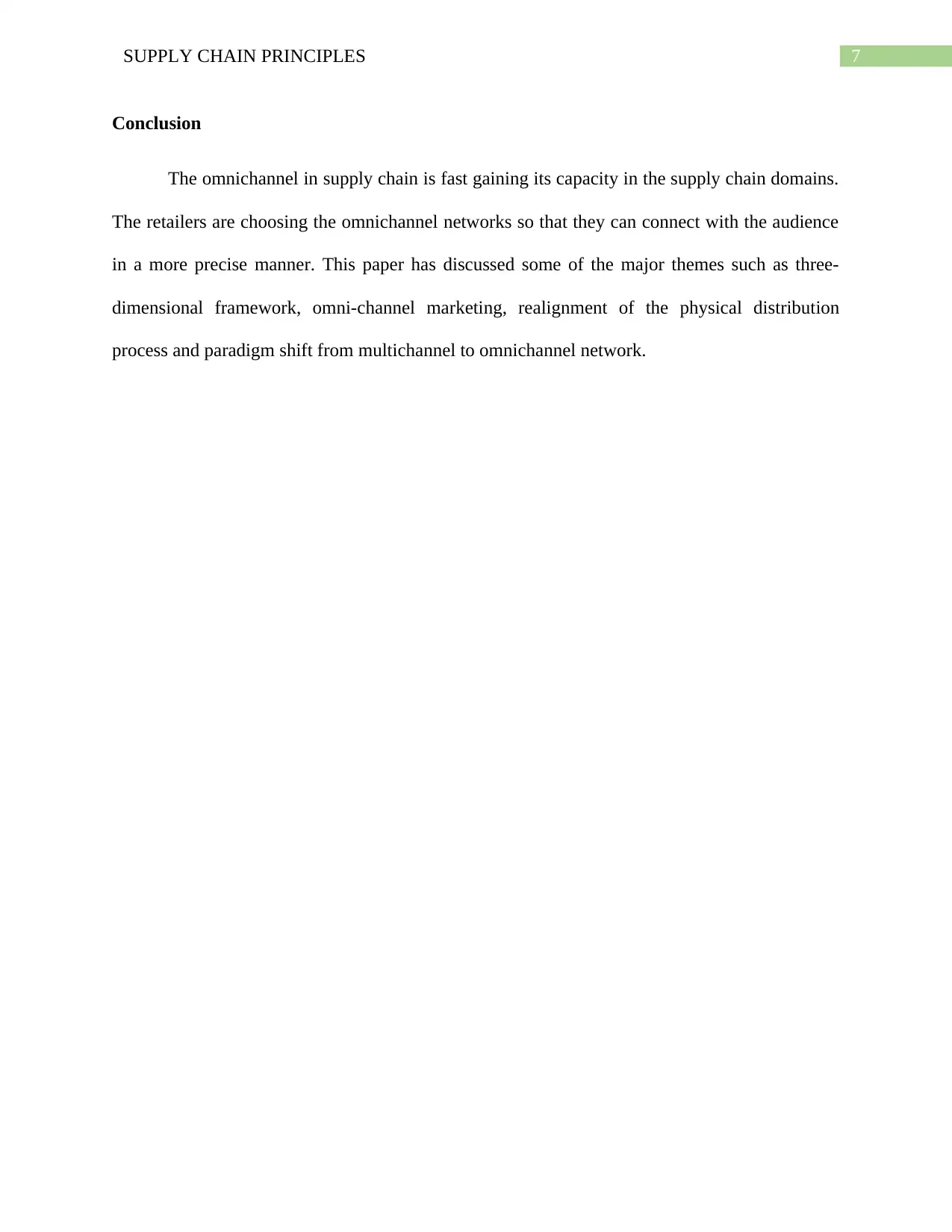
7SUPPLY CHAIN PRINCIPLES
Conclusion
The omnichannel in supply chain is fast gaining its capacity in the supply chain domains.
The retailers are choosing the omnichannel networks so that they can connect with the audience
in a more precise manner. This paper has discussed some of the major themes such as three-
dimensional framework, omni-channel marketing, realignment of the physical distribution
process and paradigm shift from multichannel to omnichannel network.
Conclusion
The omnichannel in supply chain is fast gaining its capacity in the supply chain domains.
The retailers are choosing the omnichannel networks so that they can connect with the audience
in a more precise manner. This paper has discussed some of the major themes such as three-
dimensional framework, omni-channel marketing, realignment of the physical distribution
process and paradigm shift from multichannel to omnichannel network.
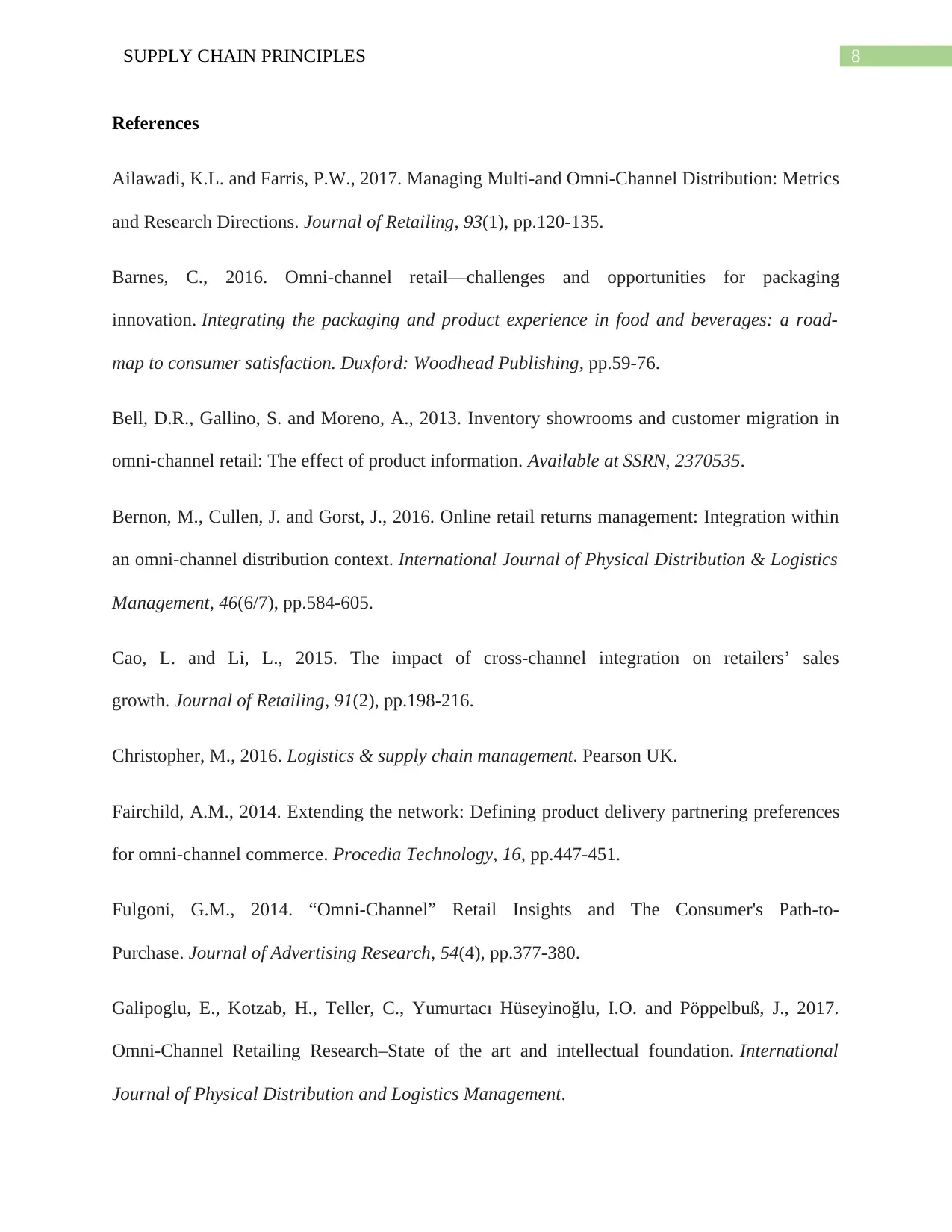
8SUPPLY CHAIN PRINCIPLES
References
Ailawadi, K.L. and Farris, P.W., 2017. Managing Multi-and Omni-Channel Distribution: Metrics
and Research Directions. Journal of Retailing, 93(1), pp.120-135.
Barnes, C., 2016. Omni-channel retail—challenges and opportunities for packaging
innovation. Integrating the packaging and product experience in food and beverages: a road-
map to consumer satisfaction. Duxford: Woodhead Publishing, pp.59-76.
Bell, D.R., Gallino, S. and Moreno, A., 2013. Inventory showrooms and customer migration in
omni-channel retail: The effect of product information. Available at SSRN, 2370535.
Bernon, M., Cullen, J. and Gorst, J., 2016. Online retail returns management: Integration within
an omni-channel distribution context. International Journal of Physical Distribution & Logistics
Management, 46(6/7), pp.584-605.
Cao, L. and Li, L., 2015. The impact of cross-channel integration on retailers’ sales
growth. Journal of Retailing, 91(2), pp.198-216.
Christopher, M., 2016. Logistics & supply chain management. Pearson UK.
Fairchild, A.M., 2014. Extending the network: Defining product delivery partnering preferences
for omni-channel commerce. Procedia Technology, 16, pp.447-451.
Fulgoni, G.M., 2014. “Omni-Channel” Retail Insights and The Consumer's Path-to-
Purchase. Journal of Advertising Research, 54(4), pp.377-380.
Galipoglu, E., Kotzab, H., Teller, C., Yumurtacı Hüseyinoğlu, I.O. and Pöppelbuß, J., 2017.
Omni-Channel Retailing Research–State of the art and intellectual foundation. International
Journal of Physical Distribution and Logistics Management.
References
Ailawadi, K.L. and Farris, P.W., 2017. Managing Multi-and Omni-Channel Distribution: Metrics
and Research Directions. Journal of Retailing, 93(1), pp.120-135.
Barnes, C., 2016. Omni-channel retail—challenges and opportunities for packaging
innovation. Integrating the packaging and product experience in food and beverages: a road-
map to consumer satisfaction. Duxford: Woodhead Publishing, pp.59-76.
Bell, D.R., Gallino, S. and Moreno, A., 2013. Inventory showrooms and customer migration in
omni-channel retail: The effect of product information. Available at SSRN, 2370535.
Bernon, M., Cullen, J. and Gorst, J., 2016. Online retail returns management: Integration within
an omni-channel distribution context. International Journal of Physical Distribution & Logistics
Management, 46(6/7), pp.584-605.
Cao, L. and Li, L., 2015. The impact of cross-channel integration on retailers’ sales
growth. Journal of Retailing, 91(2), pp.198-216.
Christopher, M., 2016. Logistics & supply chain management. Pearson UK.
Fairchild, A.M., 2014. Extending the network: Defining product delivery partnering preferences
for omni-channel commerce. Procedia Technology, 16, pp.447-451.
Fulgoni, G.M., 2014. “Omni-Channel” Retail Insights and The Consumer's Path-to-
Purchase. Journal of Advertising Research, 54(4), pp.377-380.
Galipoglu, E., Kotzab, H., Teller, C., Yumurtacı Hüseyinoğlu, I.O. and Pöppelbuß, J., 2017.
Omni-Channel Retailing Research–State of the art and intellectual foundation. International
Journal of Physical Distribution and Logistics Management.
⊘ This is a preview!⊘
Do you want full access?
Subscribe today to unlock all pages.

Trusted by 1+ million students worldwide
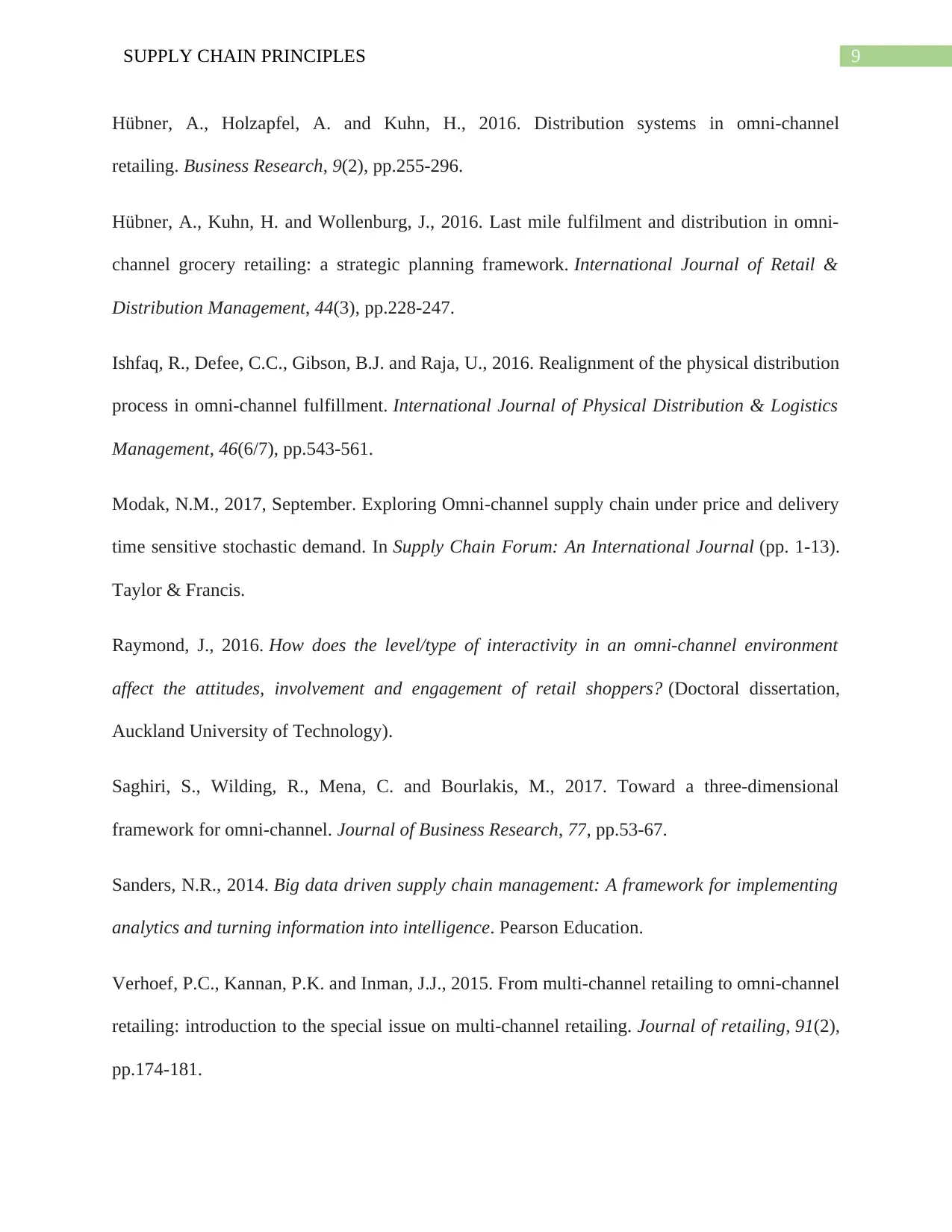
9SUPPLY CHAIN PRINCIPLES
Hübner, A., Holzapfel, A. and Kuhn, H., 2016. Distribution systems in omni-channel
retailing. Business Research, 9(2), pp.255-296.
Hübner, A., Kuhn, H. and Wollenburg, J., 2016. Last mile fulfilment and distribution in omni-
channel grocery retailing: a strategic planning framework. International Journal of Retail &
Distribution Management, 44(3), pp.228-247.
Ishfaq, R., Defee, C.C., Gibson, B.J. and Raja, U., 2016. Realignment of the physical distribution
process in omni-channel fulfillment. International Journal of Physical Distribution & Logistics
Management, 46(6/7), pp.543-561.
Modak, N.M., 2017, September. Exploring Omni-channel supply chain under price and delivery
time sensitive stochastic demand. In Supply Chain Forum: An International Journal (pp. 1-13).
Taylor & Francis.
Raymond, J., 2016. How does the level/type of interactivity in an omni-channel environment
affect the attitudes, involvement and engagement of retail shoppers? (Doctoral dissertation,
Auckland University of Technology).
Saghiri, S., Wilding, R., Mena, C. and Bourlakis, M., 2017. Toward a three-dimensional
framework for omni-channel. Journal of Business Research, 77, pp.53-67.
Sanders, N.R., 2014. Big data driven supply chain management: A framework for implementing
analytics and turning information into intelligence. Pearson Education.
Verhoef, P.C., Kannan, P.K. and Inman, J.J., 2015. From multi-channel retailing to omni-channel
retailing: introduction to the special issue on multi-channel retailing. Journal of retailing, 91(2),
pp.174-181.
Hübner, A., Holzapfel, A. and Kuhn, H., 2016. Distribution systems in omni-channel
retailing. Business Research, 9(2), pp.255-296.
Hübner, A., Kuhn, H. and Wollenburg, J., 2016. Last mile fulfilment and distribution in omni-
channel grocery retailing: a strategic planning framework. International Journal of Retail &
Distribution Management, 44(3), pp.228-247.
Ishfaq, R., Defee, C.C., Gibson, B.J. and Raja, U., 2016. Realignment of the physical distribution
process in omni-channel fulfillment. International Journal of Physical Distribution & Logistics
Management, 46(6/7), pp.543-561.
Modak, N.M., 2017, September. Exploring Omni-channel supply chain under price and delivery
time sensitive stochastic demand. In Supply Chain Forum: An International Journal (pp. 1-13).
Taylor & Francis.
Raymond, J., 2016. How does the level/type of interactivity in an omni-channel environment
affect the attitudes, involvement and engagement of retail shoppers? (Doctoral dissertation,
Auckland University of Technology).
Saghiri, S., Wilding, R., Mena, C. and Bourlakis, M., 2017. Toward a three-dimensional
framework for omni-channel. Journal of Business Research, 77, pp.53-67.
Sanders, N.R., 2014. Big data driven supply chain management: A framework for implementing
analytics and turning information into intelligence. Pearson Education.
Verhoef, P.C., Kannan, P.K. and Inman, J.J., 2015. From multi-channel retailing to omni-channel
retailing: introduction to the special issue on multi-channel retailing. Journal of retailing, 91(2),
pp.174-181.
1 out of 10
Related Documents
Your All-in-One AI-Powered Toolkit for Academic Success.
+13062052269
info@desklib.com
Available 24*7 on WhatsApp / Email
![[object Object]](/_next/static/media/star-bottom.7253800d.svg)
Unlock your academic potential
Copyright © 2020–2025 A2Z Services. All Rights Reserved. Developed and managed by ZUCOL.





